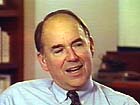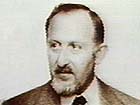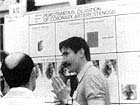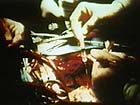| Interview John E. Abele, Part II |
||
| |
|
|

|
Last
week we began a multi-part interview with John E. Abele, Founder Chairman
of Boston Scientific Corporation. Mr. Abele began his involvement
with the field of minimally invasive medicine over three decades ago.
Today Boston Scientific Corporation is a worldwide leader in the manufacturing
of devices for interventional cardiology and radiology. |
|
|
Access previously posted interviews. |
||
| Q:
As you've said, angioplasty really started with Dotter. How did Gruentzig
come in contact with this idea? Abele: Gruentzig had been inspired with the concept when he met Hardy Zeitler at one of his conferences on peripheral angioplasty. That's when Zeitler was using the Dotter technique, and in fact had done more procedures than Dotter at that point. |
 Prof. Eberhard Zeitler |
|
| So
Gruentzig applied his balloon concept to the same peripheral patient
that Zeitler had been using the coaxial tubular catheter dilatation
technique on. And [Gruentzig] ended up over a period of three years
doing about 270 patients. No mean feat in Zurich, where every patient
had to be released by the surgeons for his technique. I sat in a conference
where they were going over a patient and determining whether they
should do angioplasty or surgery and it really was awfully difficult
for Gruentzig to go through the demeaning process that allowed him
to do the procedure.
Nevertheless
he managed to compile a pretty significant collection of [peripheral]
patients and was extremely careful in both the original data monitoring
and the follow-up data. He had wanted to go to the coronaries, so
he had conducted experiments in coronaries in cadavers and in animals. |
||
 Gruentzig with poster exhibit at 1976 AHA meeting |
Q:
How did Gruentzig first present his experience and discovery? Abele: In 1976, in November, he came over to the American Heart Association, which was in Miami at the time, and presented his poster supporting that concept of percutaneous transluminal dilatation of the coronary artery in dogs, as well as his human peripheral data. |
|
| I'd
actually called up Dick Myler before hand and said, "Hey, Dick! Remember
that thing, that work we did some years ago in the coronary artery?
I think this guy's figured it out. He's somebody you gotta meet!"
And so Dick
came down and we met together and I had stayed by the booth with
Andreas to give him some guidance on who was coming up and who was
asking questions. And Bob Hall, he was and still is a cardiologist-in-chief
at the Texas Heart, he came up and in his marvelous style asked
him a series of questions, but kind of set-up questions. And Gruentzig
was just incredibly well-prepared, and in his very ingenuous and
humble way answered every question and then asked some questions
that he had in his own mind that Hall hadn't thought of. And it
was the sort of thing that even the most cynical of people, looking
at this very significant and provocative new procedure, had to be
impressed by. | ||
| Q:
When did Gruentzig start working in the human coronaries? Abele: He came over to the U.S. and did his first case with Myler, which was really an experimentation in a surgery, where they dilated a vessel that had been bypassed to determine whether the concept was correct. I think with device development, prior to that, one did not do anywhere near as much laboratory testing and animal testing and cadaver testing as he did. |
 1st intraoperative coronary angioplasty is performed in San Francisco in May 1977 |
|
| And
he was doing it to learn, but he was also doing it to communicate
to the critics that he had tested every conceivable way you could,
what these risks were going to be, recognizing that you just can't
model the diseased human artery. Q: Then he went back to Zurich to do his first live case in the cath lab? Abele: The first patient was an insurance salesman. He was chosen partly for his medical condition and partly for his mental attitude. There are some people who have a risk-taking profile or personality that's greater than others and they make good candidates for experimental procedures. And this fellow was enthusiastic and confident in Andreas. Obviously Andreas's personality was fabulous for dealing with somebody like that, because he explained things extremely clearly and certainly informed him of the risks, but did it in a way that was very balanced. |
||
 |
One
thing that I think a lot of people overlook, is the fact that he designed
his investigational plan, if you will, upside-down from what everybody,
in the cardiac world anyway, had been doing. In other words, he started
out on the least risky patients. Traditionally if you
were working with a valve, or whatever it is, you would choose non-surgical
candidates. You would choose "train wrecks" who had no other possibility
of therapy. |
|
| In
some ways that may make sense but, from a procedural point of view,
it makes it more difficult to achieve success and to know what really
is important because the problem may be the fact that the patient
was so sick they wouldn't survive anyway. And he determined that he
was going to choose single discrete lesions in vessels that weren't
critical to the survival of the patient. So if he did have a disaster,
they could still go to surgery and the patient would be okay. And,
again, you tend to assume that, "Well, that's an obvious idea!" But
that was counter-intuitive and absolutely against the practice that
had been followed up until that time. After the procedure had been completed and the patient learned that he was successful, he called the newspaper because he thought he was doing Andreas a favor as well as, of course, getting a little bit of publicity for himself. And Andreas learned and stopped that effort. What Andreas was concerned about was that any reputable peer-reviewed scientific publication would have concerns about reporting on data that had already appeared in the "retail press", so to speak. He was also concerned, however, that if he didn't get to publishing quickly, other people would copy what he was doing and displace him. And because he was kind of a "nobody from Zurich", he knew he was at risk and there had been people in the United States who were well aware of this. He had met those people and he knew they were quite aggressive. | ||
| So
he arranged, and this is where Myler helped, to write a letter to
the editor of Lancet. And Lancet is a quick turn-around
publication, so the first experience appeared in Lancet, and
that sort of put his stake in the ground. And there would be in the
next several years numerous incidents of situations in which people
would try to take credit for the development of the procedure. And
they might mention that there was a Swiss cardiologist who was doing
it, but that's about as far as it would get. |
|
|
| And,
in fact, this happened in one case with a person that he knew pretty
well, and he forgave him for this. It was rather extraordinary in
his personality that he felt it was essential to keep everybody in
this community of people who were developers of this new technique. |
||
|
Part
III: John Abele's interview continues with his personal observations
on Gruentzig's methods and motivations. |
||
| |
||
|
Angioplasty.Org Home • PatientCenter send comments & suggestions
to "info at angioplasty dot org" |
||
